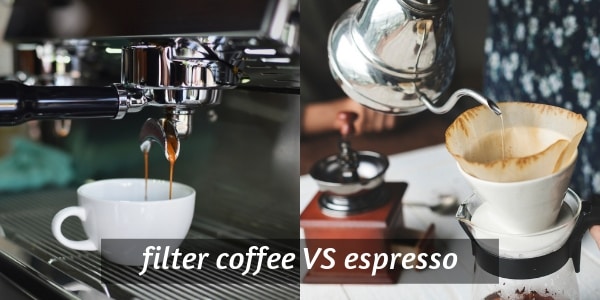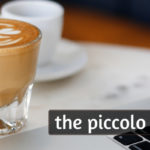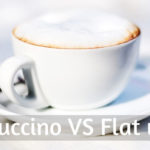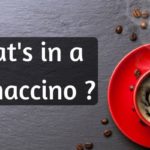Looking to compare the world's two favorite coffee drinks ? An espresso vs drip coffee comparison might be just the thing to showcase each one's qualities, and the drawbacks as well.
So let's compare the two, and see what it comes to. For reference, I'll be talking here about drip machines and pour-over coffee.
Table of Contents
1. An espresso is a coffee concentrate, filter coffee is milder
When you ask the barista for an espresso, you're asking for coffee concentrate. There is no coffee drink out there more concentrated than a shot of espresso.
It's a very strong, very flavorful coffee, and it's not for everyone.
The taste is more concentrated and it's even a bit thicker, as a liquid, than drip coffee. This is because the filter in the espresso cup doesn't trap all the residue, but allows some to pass.
This means that essential coffee oils do pass into your cup of espresso, and they're what make that beautiful crema layer on top. Much like steaming milk, in a way.
So your espresso is always going to be very, very potent. You'll be able to dilute it with some milk and still taste the coffee strongly. Even in a latte, the espresso still shines through.
As for the drip coffee, it's more of an infusion than a shot. It's got a more nuanced aroma, and it will pick up on the entirety on the notes in your coffee, not just the top notes.
It's a different coffee than the usual espresso, and it's got its own perks. One of them being sheer size, but we'll get to that in a bit.
The point is that filter coffee is a milder tasting coffee, which almost everyone knows as well as they know an espresso. Drip coffee used to have a bad reputation, especially since filter machines were popular in American diners.
Everyone's had or at least heard of the stale coffee served in a diner on the side of the road, somewhere in the U.S.
But we've come a long way from that, and brewed coffee today is much better. It's seeing a rise in popularity, especially the pour-over ones.
With pour over coffee, and drip coffee, the resulting brew is always going to be more diluted than an espresso. The paper filter is much better at catching debris and resulting in a very clean, clear cup of coffee.
2. Drip coffee comes in larger servings, espressos are always small
Since the way espresso is made requires less water than a brewed version, it's always going to be a smaller serving size than regular coffee. To be fair, you can make coffee the size of an espresso. But you'd be very unhappy with it.
So the serving size for a usual espresso is 1 oz. That's 30 ml of pure, concentrated coffee. There's 3 types of espresso, 3 sizes. The short (ristretto) is half an ounce, which is 15 ml.
The usual is the 1 ounce/30 ml one and it's the most common one, and it's what is usually used in coffee drinks like lattes or mocha.
Then there is the long espresso, which is double the amount of a normal shot of espresso, so 2 ounces/60 ml.
These measurements refer to the liquid itself, and do not count the crema forming on top of each cup of espresso.
A cup of coffee can be any size you want it to be, with a few caveats. Too short a coffee and you risk making it taste odd, since the extraction time won't be enough.
Too long a cup and you'll end up with an overextracted and watery coffee.
Most people usually take a full mug of coffee, or just a bit less, so they have room to add milk and sugar. So that puts pure brewed coffee (so, a black coffee) at about 8 ounces/236 ml, before adding anything else.
Of course, you can have more or less but no matter how you look at it, it's more coffee than an espresso.
That being said, more does not necessarily equal better. There is a time and place for sipping on a whole mug of coffee, and it depends on each person when they'd like to do that.
But if you're in a hurry and dead tired and need some coffee right this second before you go do something in a rush, then espresso is obviously going to be a better choice.
It's simply easier to drink by virtue of being less liquid.
If you like to take some extra time in the morning, to get ready and have some breakfast before you head off to work, then drip coffee is going to be just right.
That's the case in our house, and we very much treasure that simple coffee and breakfast time in the morning.
3. Brewed coffee contains slightly more caffeine
This is something that might surprise a few people, and for good reason. Though once I explain it, it's going to sound very simple indeed.
So you know how espresso is so strong, so dark, deep, rich ? Well, the process by which is becomes so doesn't allow it to fully extract all the caffeine from the coffee beans.
This is because caffeine is water soluble, yes, but needs a bit of time to extract. About 2-3 minutes, which is not the amount of time an espresso needs.
A normal, 1 ounce/30 ml shot of espresso is usually around 25-30 seconds. This is not enough time to get all the caffeine out.
A good portion of it does come out, no worries. You're still getting your caffeine kick.
It's just that filter coffee requires more time to brew, and by the time the last drop has... dropped... the caffeine that was going to dissolve did dissolve.
So yes, regular coffee does get a bit more caffeine that espresso. How much, though ?
A normal espresso shot has 40-75 mg/ per 30 ml serving, while a mug of drip coffee has about 80-185 mg per 250 ml cup. That's 0.0014-0.0026 oz of caffeine for a normal espresso, and 0.0028-0.0065 oz of caffeine for a drip coffee.
The caffeine content has an interval because caffeine content varies wildly from coffee brand to brand, some using more Arabica, some using more Robusta beans. Robusta beans have the higher caffeine content, but are much more bitter.
Adding milk or cream or sugar to your coffee, espresso or not, won't damage the caffeine. The caffeine will still do its job, but maybe a bit slower.
There is also the size to consider, since adding large amount of milk to a drip coffee is going to transform it into a very large drink, which you might not be able to consume in one sitting. Especially if you've got food on the table as well.
Now that you know this, you can adjust your preferences according to what you're looking for in your coffee.
4. Espresso machines require precision and skill
Another thing to think of is the ease of preparation. The thing is, espresso machines are bulky, yes, but they're very precise.
One step done wrong can lead to very poor tasting espresso, since there is much less coffee than in a brewed version.
You will need to know how much coffee to pack into your portafilter, and when to turn off the water. Some espresso machines are automated, and they turn off by themselves.
Of course, you can always turn them off faster.
This is largely avoided with drip machines. They're usually well programmed and the only thing you can mess up is the water to coffee ratio. That one is up to you, and has no standard recipe.
With pour-over filters, you'll need to be precise as well, since you're be looking at the coffee as it brews. There are a few extra steps to learn, and they can be very precise as well.
But overall filter coffee is much more flexible and forgiving than espresso. A coffee of 8 ounces/236 ml is going to be easy to fix if you get it wrong, with some milk and sugar.
But an espresso with something else added to it is not an espresso anymore.
Baristas are very well trained in how to properly make espresso, and pour over coffee. You can rest assured your coffee will be good.
But if you're making filter coffee with a machine, then there's not much to worry about since the process is very simple and straightforward.
5. Filter coffee is the classic, day to day coffee everyone know
Filtered coffee is very common. Everyone in this day has had brewed coffee, and has heard of filter coffee before. We've seem it in kitchens, diners, breakfast tables at a hotel buffet, and in pretty much every cop movie ever made.
This coffee is a classic, a part of many people's kitchen. It's one of the easiest, simplest ways to make coffee and pretty much anyone can operate a drip machine.
Espressos have kind of risen as a better, more expensive and 'educated' type of coffee drink.
It's gotten so popular now, that it's a bit overdone. It's also the base for the large majority of other coffee drinks.
You can't make a latte with a cup of regular coffee. Not only would you have a different taste, and a larger serving size, the crema would be nowhere to be found.
So while drip coffee was the common coffee, the coffee of the masses so to speak, espresso used to be this new, stylish coffee. Now espresso has become the standard coffee, and it's no longer a sort of status symbol.
These things happen, and at some point whatever's going to succeed the espresso will become blah and not as impressive. People get used to.
But currently, brewed coffee is still very well remembered by our parents and grandparents. Which is not a bad thing, it just goes to show how popular and easy to mass-produce it was.
(If you like this article so far, you can pin it to your Pinterest board by clicking the image below. The article continues after the image.)
6. Espresso is versatile and is used in most fancy coffee drinks
As I mentioned earlier, an espresso is the base for most coffee drinks out there. A latte without an espresso is not a latte. The latte art has no way to exist without the crema. Neither would a cappuccino.
Even iced coffee is often made with espresso that's been cooled. That's when it's not made with cold brew coffee, that is.
Espressos can be used in a multitude of drinks, because they give you that strong coffee flavor, and their thicker texture means the color won't be very faded when you apply lots of milk to the drink.
A filter coffee is much simpler, being only used as-is, or with some milk and sugar added. Of course, you can make your own drip coffee in a smaller amount, and add some steamed milk and call it a cappuccino.
But if you were to respect the coffee to milk ratios you would have a very large drink.
7. Brewed coffee uses a larger grind size
There is a bit of a difference in grind size between drip coffee and espresso. Espresso needs a very small and fine grind size, so the water has some resistance when passing through the filter at such a high pressure.
Check out this article to see how grind size affects coffee.
It also helps the coffee release flavor faster, but the flavor will be different that if you used larger grinds.
Then again, larger grinds won't make an espresso. They would make a very watery drink with very little crema.
A drip coffee needs a small grind as well, but slightly larger. Actually, it needs medium or medium-fine grinds.
Since the way the coffee drips is by gravity and not pushed through by sheer pressure, the coffee grounds need to be larger.
The water will stay in contact with the grounds longer than in an espresso machine, and this means it will be able to extract more flavor and nuances in your cup of coffee.
It might sound like an unimportant matter, but using the right grind size can make or break your coffee.
If you were to use the smallest, finest grind size for filter coffee, you would get an overextracted coffee, and the brewing time would be longer since the water will have trouble dripping through the thick, fine coffee sludge.
8. An espresso is a quick job, done in a minute
Espressos are a quick job, they're done much faster than drip coffee. Assuming you've already ground your coffee to the right size, the whole process of making an espresso will only take a minute.
Setting up the machine, putting the coffee in the portafilter, and turning it on takes as long as the coffee does to brew. So with a 25-30 second brewing time, you'll get a cup of coffee in a minute.
Compare this to a brewed coffee, which might take about 3 minutes, and the difference is very clear.
The again, 3 minutes to wait for a cup of good coffee is not that much to ask for. It's a lot if you're in a rush, but it's still a very manageable time.
9. Brewed coffee can be made in large quantities, espressos are single-serve
When it comes to how quickly you can serve a bunch of guests, regular coffee is going to be friendlier.
Many filter machines offer the option of making several cups of coffee at once, some of them even 12 cups. Note that these are cups about 4 ounces/120 ml per cup.
And if you've got a large group of guests waiting for their coffee, brewing a pot of coffee and serving them all at once is going to be very convenient.
As for espresso machines, they can only make an espresso at a time. Some have a double spout, but most don't.
This means that each guest is going to have a to wait a few minutes for their coffee.
Now I grew up with an espresso machine at home. It was a poor, older version and it had many faults. But it could brew cup after cup like it was nobody's business.
Still, whenever extended family would come over (which was often) I'd have to brew about 10 cups of espresso back to back. Complete with cleaning the portafilter and adding more water in the machine, as needed.
The whole process would take up to half an hour in many cases, and there was much hustling and bustling involved.
If your guests don't mind waiting a bit for the coffee to be served, then I'd guess and espresso wouldn't be a bad idea.
But given my experience with back to back espressos, I would recommend the drip-filter machine, simply for the ease of use by the host. Add to that that many people take their coffee very simple when they're visiting, which is just some milk and sugar.
At that point, an espresso's versatility and use is pretty much wasted on simple coffee versions.
Ah well, to each their own I guess. Those were my two cents on serving guests, and I prefer a drip filter for this reason.
Final thoughts
Whichever coffee brewing method you opt for, that's your business. These were the main differences between them, and they each have their own purposes.
I for one have drip coffee, and wouldn't go back to an espresso machine just because it seems like a bit of a waste in a home that one has coffee in the morning.
It's much simpler to just brew a small pot of coffee in the morning and be done with it. Then again, I know people who wouldn't be able to get past their day without an espresso, and love their espresso machines dearly. Which is most of my family.
If you want to know more about coffee or tea, feel free to check the related articles below. Who knows what else you might find ?






